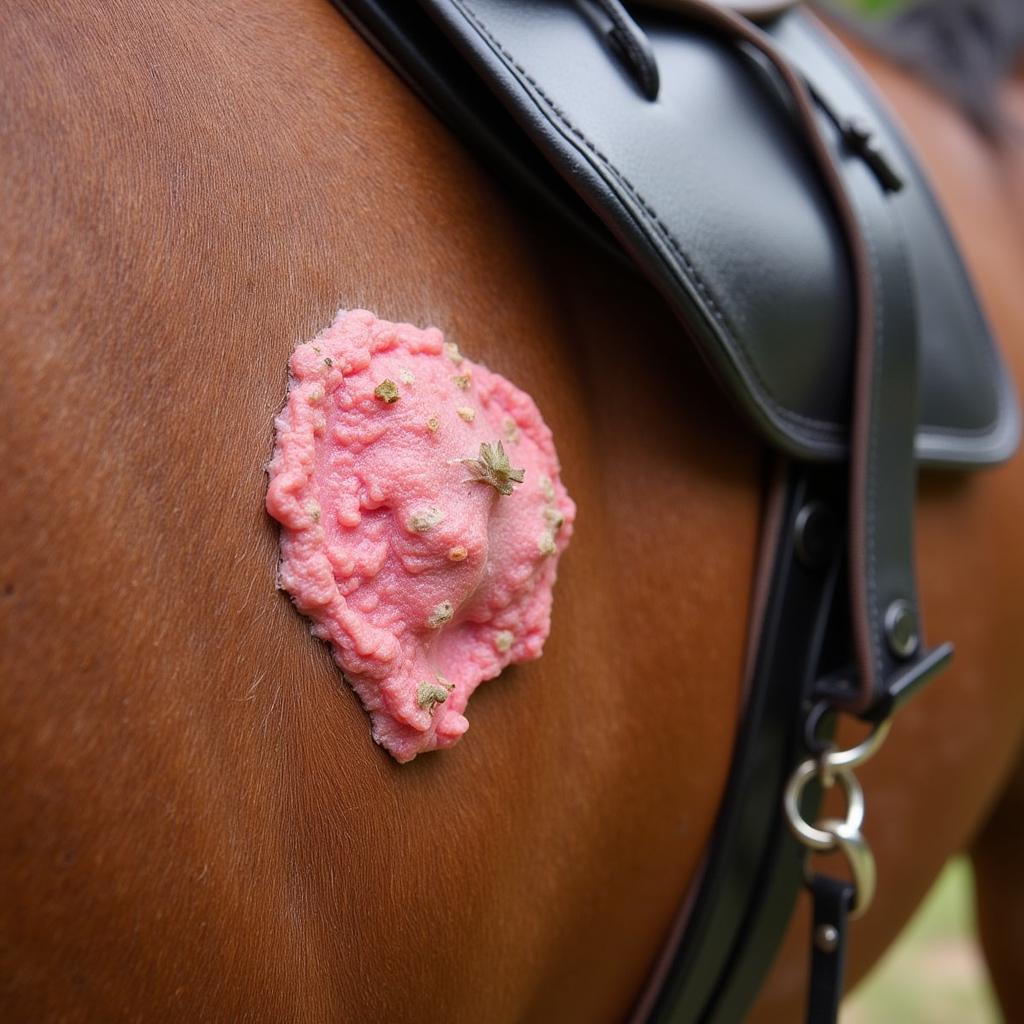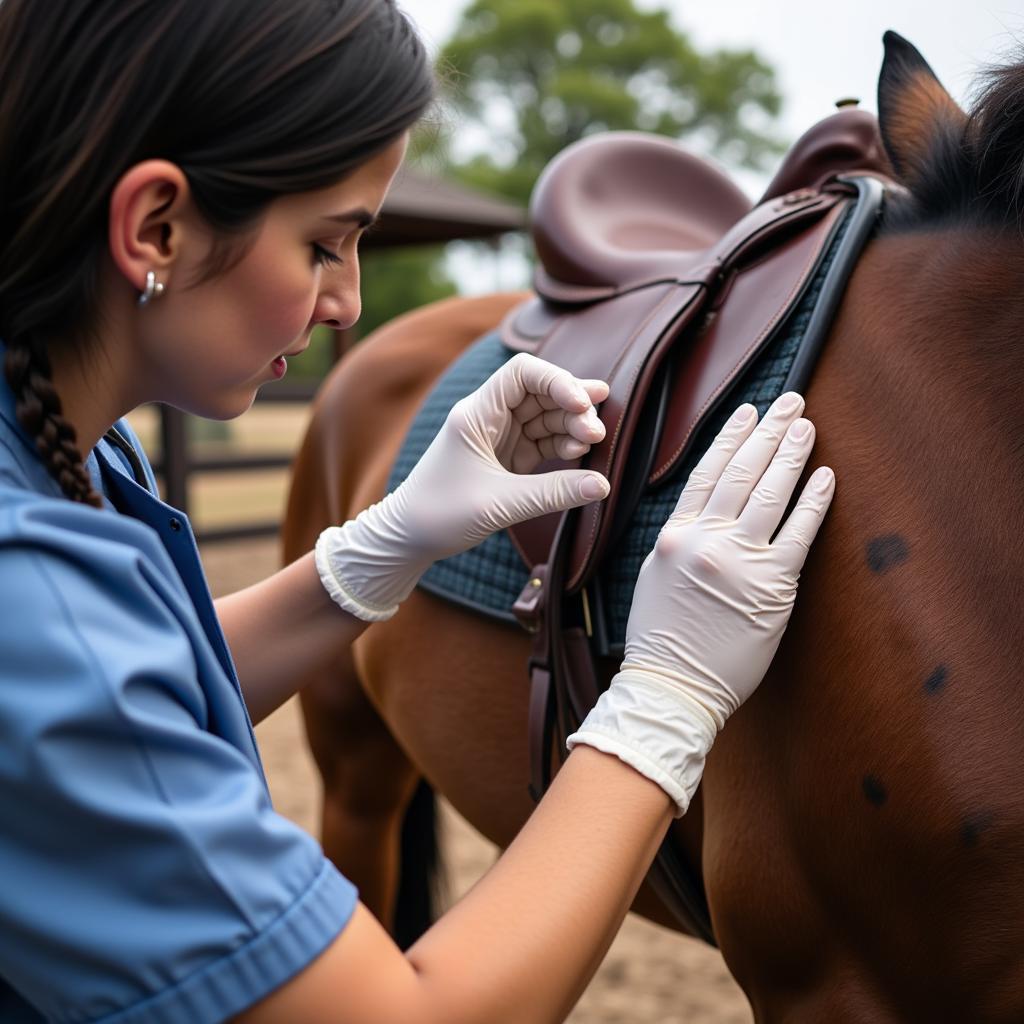Saddle sores on horses, a common ailment for equine companions, can cause discomfort and hinder performance. Understanding the causes, symptoms, and treatment options is crucial for horse owners to ensure their equine partners’ well-being.
Recognizing Saddle Sores in Horses
Saddle sores, also known as girth galls, manifest as painful lesions on a horse’s back, primarily in the area where the saddle and girth rest.
 Saddle Sore on Horse's Back
Saddle Sore on Horse's Back
These sores result from friction or pressure, often caused by an ill-fitting saddle, incorrect saddling techniques, or riding for extended durations.
Common Causes of Saddle Sores
- Ill-fitting saddle: A saddle that pinches, rubs, or distributes weight unevenly is a primary culprit behind saddle sores.
- Incorrect saddle placement: Positioning the saddle too far forward or back can lead to pressure points and chafing.
- Dirty or wrinkled saddle pads: Dirt and debris trapped beneath the saddle pad create friction, while wrinkles can cause localized pressure points.
- Riding for prolonged periods: Extended riding, especially without adequate breaks, increases friction and heat buildup, making the horse susceptible to sores.
Types of Saddle Sores
Saddle sores present themselves in varying degrees of severity. Recognizing the different types is crucial for determining appropriate treatment:
- Dry Sore: The mildest form, appearing as a dry, irritated patch of skin.
- Moist Sore: A more advanced stage, characterized by hair loss, redness, and oozing.
- Swelling: Significant inflammation and swelling around the affected area.
- Open Sore: An open wound susceptible to infection.
Treating Saddle Sores
The key to effectively treating saddle sores is to address the underlying cause and provide appropriate wound care.
Steps for Treating Saddle Sores
- Identify and eliminate the cause: Ensure a properly fitted saddle, correct saddle placement, and clean, wrinkle-free saddle pads.
- Clean the affected area: Gently wash the sore with mild antibacterial soap and warm water.
- Apply antiseptic solution: After cleaning, apply a veterinarian-recommended antiseptic solution to prevent infection.
- Keep the area dry and clean: Allow the sore to air dry and keep the area clean and free from debris.
- Provide rest: Rest is crucial for healing. Avoid riding the horse until the sore has completely healed.
 Veterinarian Examining Saddle Sore
Veterinarian Examining Saddle Sore
When to Consult a Veterinarian
While minor saddle sores often heal with proper care, it’s essential to seek veterinary attention if:
- The sore is severe, deep, or infected.
- The horse exhibits signs of pain, such as lameness or reluctance to be saddled.
- The sore does not show improvement within a week of treatment.
Preventing Saddle Sores: Proactive Measures
Prevention is always better than cure. Implementing proactive measures can significantly minimize the risk of saddle sores:
- Ensure proper saddle fit: Schedule regular saddle fitting appointments with a qualified saddle fitter, especially if the horse is still growing or its workload changes.
- Use appropriate saddle pads: Choose high-quality saddle pads that provide adequate cushioning and wick away moisture. Wash saddle pads regularly.
- Practice correct saddling techniques: Ensure the saddle is placed correctly and the girth is tightened gradually.
- Introduce new tack gradually: When using new tack, introduce it slowly, allowing the horse to acclimate.
- Inspect your horse’s back regularly: After each ride, thoroughly check the horse’s back for any signs of irritation or sores.
 Grooming Horse with Proper Saddle Fit
Grooming Horse with Proper Saddle Fit
Frequently Asked Questions About Saddle Sores
Q: How long does it take for a saddle sore to heal?
A: The healing time for a saddle sore varies depending on its severity and the horse’s overall health. Minor sores may heal within a week or two, while more severe sores can take several weeks or even months.
Q: Can I ride my horse with a saddle sore?
A: It is not recommended to ride a horse with a saddle sore, as it can worsen the condition and delay healing. Rest is crucial for recovery.
Q: Are certain breeds of horses more prone to saddle sores?
A: While any horse can develop saddle sores, breeds with sensitive skin or conformational traits that make them prone to pressure points may be more susceptible.
Seeking Expert Advice for Your Horse’s Well-being
Understanding and addressing saddle sores is essential for maintaining your horse’s comfort and performance. Remember, early detection and prompt treatment are crucial for a swift recovery.
For personalized advice and assistance with saddle fitting, tack selection, or any concerns regarding saddle sores, don’t hesitate to reach out to our team at Justus Horses USA. Our equine experts are dedicated to providing you with the knowledge and support you need to keep your horse happy and healthy.
Contact Justus Horses USA:
Phone: 0772127271
Email: [email protected]
Address: QGM2+WX2, Vị Trung, Vị Thuỷ, Hậu Giang, Việt Nam
Our dedicated customer support team is available 24/7 to address your inquiries.
Explore More Resources on Horse Care:
- Learn about wither horse anatomy and common issues.
- Discover insights into hock sores on horses and their management.
- Enhance your understanding of horse saddle seat types and their purposes.
- Find the best horse saddle pads for your equine partner’s comfort.
- Master the art of how to measure a horse for saddle fitting.